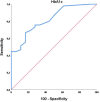Fatty pancreas disease in newly diagnosed type 2 diabetes patients: a case-control study on relationships with glycemic control and exocrine function
- PMID: 40148975
- PMCID: PMC11951613
- DOI: 10.1186/s13098-025-01663-2
Fatty pancreas disease in newly diagnosed type 2 diabetes patients: a case-control study on relationships with glycemic control and exocrine function
Abstract
Background: Fatty pancreas disease (FPD) is characterized by abnormal fat accumulation in pancreatic tissue and is often associated with obesity, metabolic syndrome, and type 2 diabetes mellitus (T2DM). While its pathophysiology and impact on pancreatic functions have been explored, the interplay between FPD, glycemic control, and exocrine dysfunction in T2DM remains inadequately defined. This study aimed to evaluate the presence of FPD, the factors affecting it, and its relationship with endocrine and exocrine pancreatic functions in newly diagnosed T2DM.
Methods: A total of 126 individuals were included in the study, comprising 63 newly diagnosed T2DM patients and 63 healthy controls matched for age, sex, body mass index and body fat distribution. Body composition, biochemical parameters (glucose, insulin, C-peptide, HbA1c), fecal elastase levels, and pancreatic/hepatic steatosis grades (evaluated using ultrasonography) were assessed.
Results: Newly diagnosed T2DM patients presented significantly higher hepatic steatosis grades (p = 0.018) and lower fecal elastase levels (p < 0.001) compared to controls. Pancreatic exocrine insufficiency was more prevalent in the T2DM group (p < 0,001). A positive correlation was observed between the FPD grade, hepatic steatosis grade, and hepatic fat fraction. A negative and statistically significant correlation (p < 0.05) was observed between FPD grade and fecal elastase level (r = -0.264). HbA1c levels demonstrated a nonlinear (inverse U-shaped) relationship with FPD, peaking at 9.8% and declining thereafter, while showing a continuous negative relationship with fecal elastase levels. HbA1c predicted low fecal elastase (< 200 μg/g) with a cutoff value of 7.4%. Patients with HbA1c levels > 9.8% presented with reduced FPD alongside persistent exocrine insufficiency.
Conclusions: Fatty pancreas disease is closely associated with hepatic steatosis, glycemic control, and exocrine pancreatic dysfunction in newly diagnosed T2DM patients. The interplay between FPD, glycemic control, and exocrine dysfunction highlights the need for comprehensive metabolic assessments in this population.
Keywords: Exocrine pancreatic insufficiency; Fatty pancreas disease; Fecal elastase; HbA1c; Hepatic fat fraction; Hepatic steatosis; Intra-pancreatic fat deposition.
© 2025. The Author(s).
Conflict of interest statement
Declarations. Ethics approval and consent to participate: All the authors contributed significantly to the research and the manuscript. The manuscript has been read and approved by all authors, and we confirm that each author meets the authorship criteria outlined in the journal’s guidelines. Furthermore, all the authors believe that the manuscript represents honest and original work. Consent for publication: Not applicable. Competing interests: The authors declare no competing interests.
Figures



References
-
- Petrov MS, Taylor R. Intra-pancreatic fat deposition: bringing hidden fat to the fore. Nat Rev Gastroenterol Hepatol. 2022;19(3):153–68. - PubMed
-
- Younossi ZM, Koenig AB, Abdelatif D, Fazel Y, Henry L, Wymer M. Global epidemiology of nonalcoholic fatty liver disease-Meta-analytic assessment of prevalence, incidence, and outcomes. Hepatology. 2016;64(1):73–84. - PubMed
-
- Tushuizen ME, Bunck MC, Pouwels PJ, Bontemps S, van Waesberghe JH, Schindhelm RK, et al. Pancreatic fat content and beta-cell function in men with and without type 2 diabetes. Diabetes Care. 2007;30(11):2916–21. - PubMed
Publication types
LinkOut - more resources
Full Text Sources

